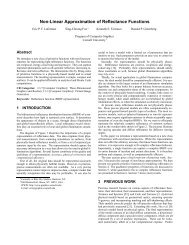pigmented colorants: dependence on media and time - Cornell ...
pigmented colorants: dependence on media and time - Cornell ...
pigmented colorants: dependence on media and time - Cornell ...
Create successful ePaper yourself
Turn your PDF publications into a flip-book with our unique Google optimized e-Paper software.
provide the underlying color to a paint, the binder determines the primary optical<br />
<strong>and</strong> textural characteristics, as well as the working properties of the paint.<br />
In additi<strong>on</strong>, other substances may be added to further manipulate paint at-<br />
tributes. An artist may add a vehicle to dilute the pigment-binder mixture, allow-<br />
ing the paint to be spread more easily. This substance has no adhesive properties<br />
<strong>and</strong> evaporates after brush marks have been made. For instance, in oil paint, nat-<br />
ural gum turpentine is often used as a vehicle. Other materials may be added to<br />
enhance the optical or textural characteristics of the paint surface. For years the<br />
str<strong>on</strong>g, <strong>and</strong> bright colors in Venetian Renaissance paintings mystified art historians.<br />
It turns out that artists were experimental chemists that would mix unc<strong>on</strong>venti<strong>on</strong>al<br />
ingredients. Ground particles of glass were added to the palette to enhance the<br />
reflective properties of the paint, which would make objects <strong>and</strong> figures in their<br />
paintings appear to glow [Goh05]. An artist can also alter the working properties<br />
of the paint, such as viscosity <strong>and</strong> h<strong>and</strong>ling. Many materials (wax, for example)<br />
are added to permit the sculpting of the topology of the surface. Further, <strong>on</strong>e can<br />
even accelerate or deter drying or make the paint more or less fluid, if desired.<br />
Our percepti<strong>on</strong> of color in a painting depends <strong>on</strong> the interacti<strong>on</strong>s between light<br />
<strong>and</strong> the layers of paint. In order to underst<strong>and</strong> how the same pigment looks<br />
different when suspended in different <strong>media</strong>, we must first analyze the optics of<br />
paint films. When a ray of light hits a surface it is either reflected off the surface,<br />
transmitted through the material, or absorbed into the material.<br />
The way light reacts to a surface is known as the Bidirecti<strong>on</strong>al Reflectance<br />
Distributi<strong>on</strong> Functi<strong>on</strong> (BRDF) of the surface. This reflecti<strong>on</strong> can be as simple as<br />
being uniform in all directi<strong>on</strong>s, comm<strong>on</strong>ly called diffuse. Diffuse reflecti<strong>on</strong>s are<br />
typically the result of rough surfaces, <strong>and</strong> are characterized as matte or dull in<br />
28



